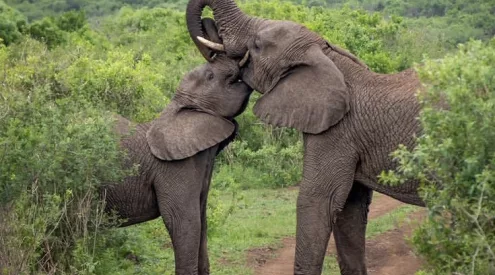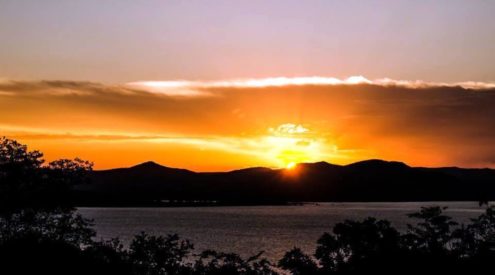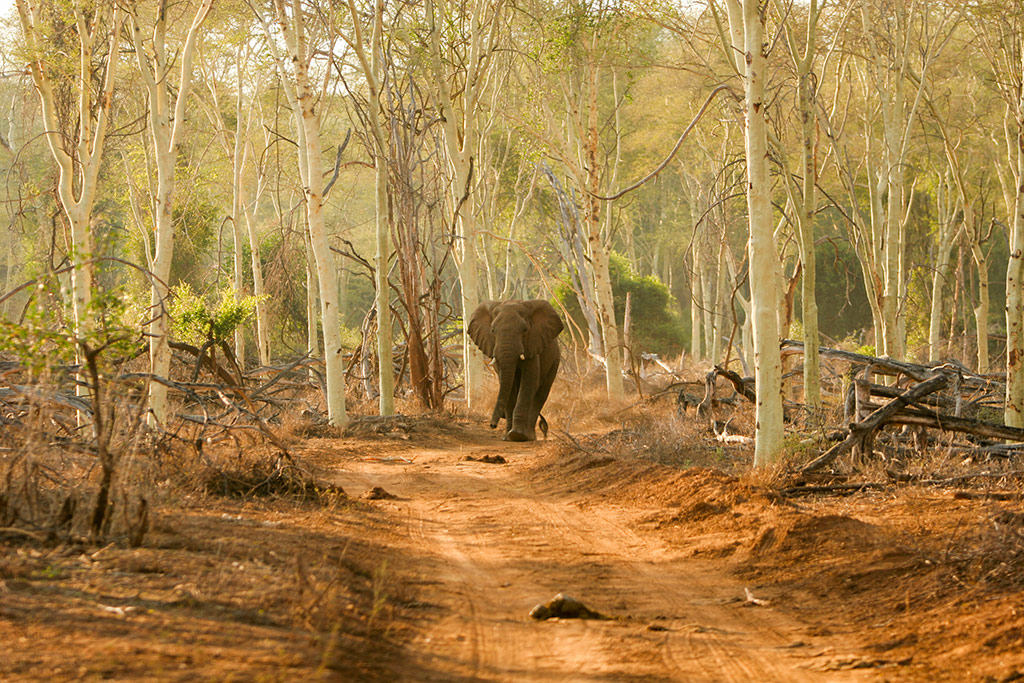A walking trail in Kruger is the best way to make the bush come alive. Did you know only six percent of the Kruger National Park is accessible to visitors via the main public roads? Isn’t it time you explored the other 94 percent? You can do that on these eight amazing walks we tested. Written by Melanie van Zyl, with Pafuri section by Anton Crone.
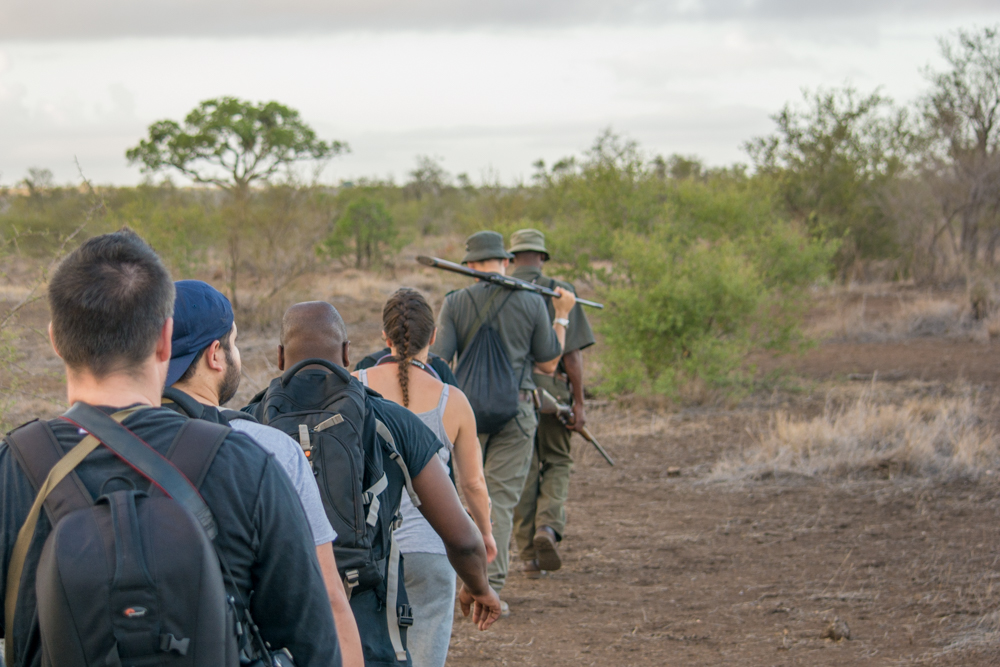
Photo by Melanie van Zyl.
Multi-day walking trails in Kruger
1. Olifants Wilderness Trail
The Olifants Wilderness Trail is a three-night foray along the Olifants River for walkers keen on experiencing the smaller details of the reserve without the barrier of a vehicle. Humans are pretty bad at keeping quiet, easy to smell, and seen as the ultimate predator, so experiencing big mammals on foot is rare.
Still, nothing makes you feel your mortality more keenly than knowing there’s a lion nearby. And you’re on foot. Your heart thunders and every single sense is so heightened you discover you’re really just an animal seeking survival too.
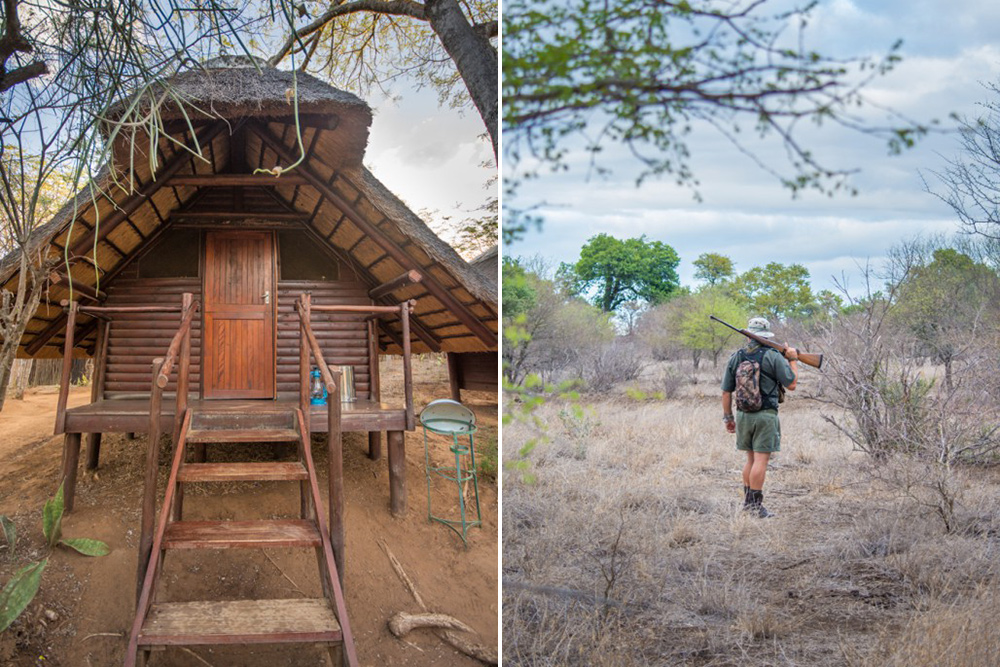
Left: our homes for three nights. Each A-frame sleeps two and there are four in total. If you don’t completely book out the walk with eight people, you could bunk with people you don’t know. Right: on all walks, you are accompanied by two experienced rangers equipped with rifles.
We set off at dawn, our guides, Steven Oosthuizen and Excellent Hlatshwayo in the lead, each armed with a rifle. Branches snapped, grass crunched and the drought-stricken landscape did little to hide us from possible predators. Now and then we stopped to read the bushveld.
‘Tannins in leaves turn the dung of browsers like the elephant and black rhino a russet red when it’s fresh,’ said Steven. He nudged the fresh deposit with his boot and outlined the enormous elephant spoor showing the direction in which it had ambled.
‘It must have been here about an hour ago, and they move quickly. I don’t think we’ll catch him.’ He pointed out the flies next.
‘These blue flies often indicate there’s a carcass nearby.’
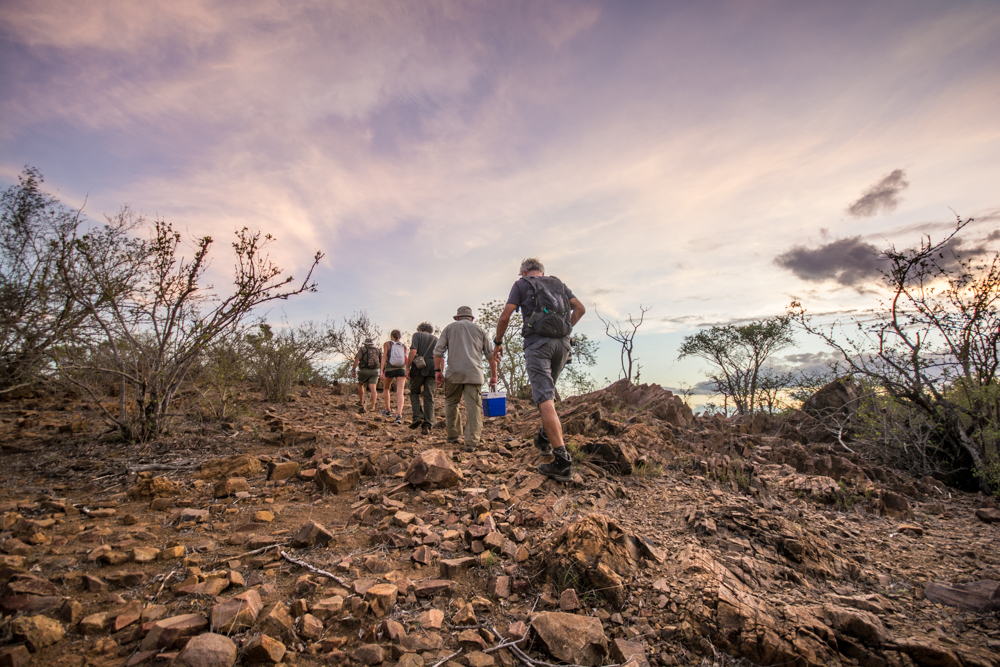
The Olifants Wilderness Trail caters to a maximum of eight people and consists of several morning and afternoon walk from a private bush camp. Photo by Melanie van Zyl.
Nearly a half-hour later the bush started cracking loudly. We moved slowly into a clearing where an elephant was eating less than 60 metres away. Excellent turned his head, listened to another sound nearby, and told us to move again.
‘Did you hear that?’ he asked me.
I heard a low grumbling but thought it was the ellie. ‘No, that was definitely a lion.’ We watched the pachyderm and strained to listen for the lion. With nothing but nature between the big bull and us, it started to move in our direction. We decided not to overstay our welcome and moved on.
Useful info about the Olifants Wilderness Trail
Each day’s walk is an average of five to six kilometres and takes roughly four hours (walks may be shortened due to weather). There’s no hard climbing or intense bundu-bashing, but relative fitness is still recommended. Bring binoculars, a camera, comfy walking shoes, and neutral, dark clothing plus a hat. Books and games are great for midday chill time.
Book: sanparks.org
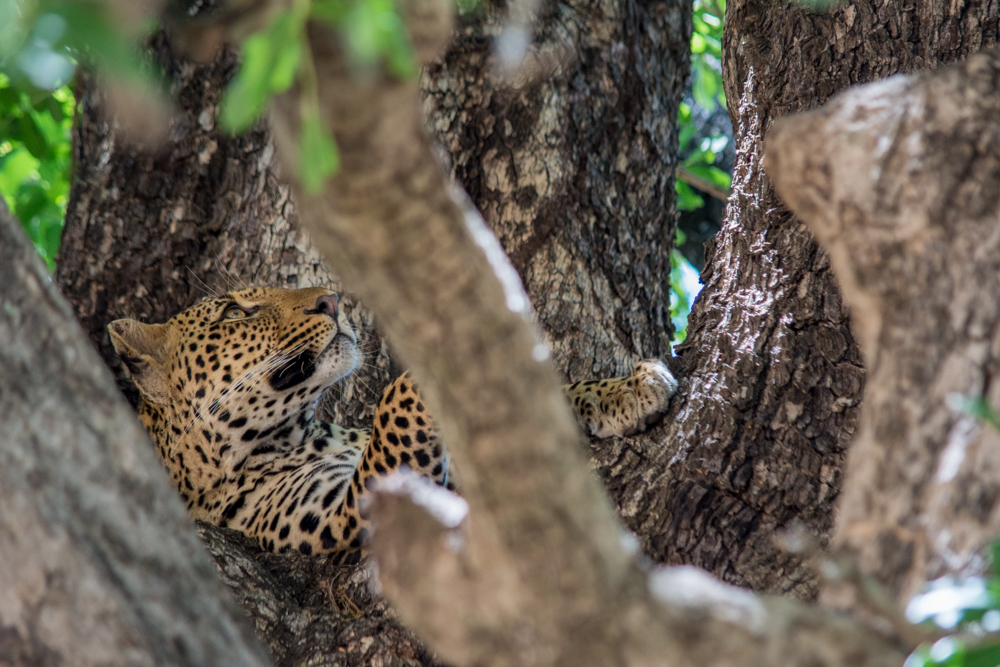
Sadly we didn’t spot any leopards on our walk, but when you’re back at camp by eight o’clock after a morning stroll, there’s more than enough time to catch up on sightings like this beauty in the afternoon. Photo by Melanie van Zyl.
2. Pafuri Walking Safaris
At the northern tip of Kruger National Park is Pafuri, a region of unparalleled beauty. Comprising roughly one percent of Kruger’s area, it’s home to plants and animals representing almost 75 percent of the park’s diversity. This is Africa condensed.
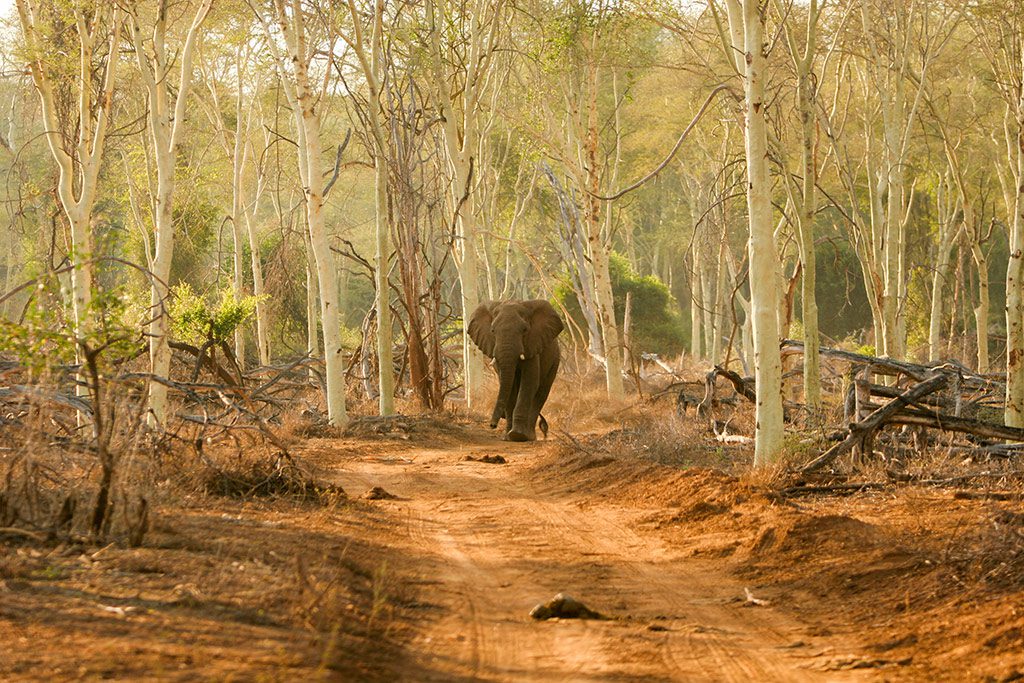
Photo by Simon Stobbs.
Walking trails here take you through one of Africa’s largest fever-tree forests as well as riverine fig forests, thorny woodland guarded by immense baobabs, and river gorges deep enough to block out the sun. Such diversity attracts a huge variety of animals, insects, and birds – it’s a twitcher’s delight with over 450 species.
Return Africa’s walking safaris explore the Makuleke Contractual Part located in the remotest part of northern Kruger giving you the chance of close encounters with the big 5 whilst having the opportunity to appreciate the finer details of the African bush. Professional safari guides share their intimate knowledge of Pafuri, all of its inhabitants and its history.
This is unrivalled walking safari country. You’ll call a seasonal bush camp home, where you’re served with fuel for the next day’s trek: rich food and drink in hearty portions. Walking safaris open from April to October each year, allowing bush lovers to celebrate a rarely-explored place that is as vast and varied as it is wild. These trails offer guests the opportunity to focus on the little things, whilst also experiencing the rush of adrenaline when you happen upon the Big Five.
You can expect to encounter an array of changing landscapes, from bushveld to riverine forests, mountains to floodplains, and perennial pans which all attract a spectacular variety of animals and birds. Discover forests of fever trees, groves of baobabs and a diverse collection of wildlife. Highlights of the experience include visits to Crook’s Corner, where the Luvuvhu and Limpopo Rivers meet, Lanner Gorge and the fever tree forest.
Cost: Pafuri walking safaris from R3205 per person per night, 3 meals a day and 2 walks per day. Max 8 guests. Minimum 2 night stay. Excludes Makuleke Conservation Levies, SANParks Entry Fees, items of a personal nature and curio shop.
Book: Tel 0116461391, returnafrica.com

Left: a dung beetle scouts the surroundings for obstacles while rolling his precious ball of life to safety. Right: We had an exceptional sighting of an elephant, so close we could hear him crunching his food. Photo by Melanie van Zyl.
Walking trails for those staying in Kruger
Did you know the following? You shouldn’t pick up tortoises – they keep a special reserve of water in a sac at the rear of their bodies and if disturbed they can dehydrate; dung beetles lay 60 eggs – one per ball of dung, which they then have to roll up hills and over rocks before being buried and, in all likelihood, dug up in winter by hungry honey badgers; hippos move like people in early-morning slippers, dragging their feet in the dirt, thereby creating ‘hippo highways’ with a ridge in the centre. These are some of the things visitors learn on Kruger’s morning walks. Melanie van Zyl picked the best to do. All of these can be booked on sanparks.org
Morning walks from the main camps start at 5 am and cost R484 per person (rates include a drink and snacks).
3. Pretoriuskop day walk
Koppies and valleys abound at Kruger’s oldest rest camp where you can spot sable and brown-headed parrots. Pretoriuskop is easily the lushest part of the park at the moment and the fresh green morning was a welcome change from the drier north. Here, we witnessed an enormous breeding herd of buffalo and spotted giraffes moving along the granite ridges.
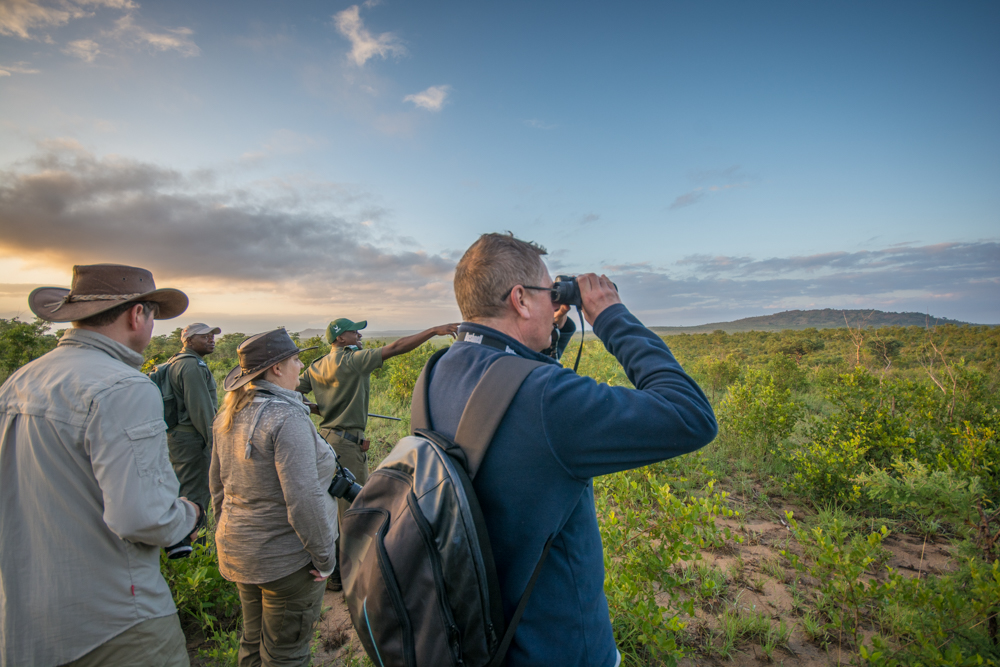
You can immediately see the more lush surroundings of Pretoriuskop. On this morning walk the light was purple, the grass green, and happiness levels high. Photo by Melanie van Zyl.
4. Lower Sabie day walk
The Lower Sabie is a wildlife hotspot in the southern Kruger savannah. The route is based at the Sabie River and walks are commonly led alongside the lively waters. Dawn was yet to break and our guides got out of the vehicle as two lions emerged from the slopes and we had to wait for them to saunter off before beginning our walk. The two males didn’t linger and the guides assured us they’re far more likely to steer clear of us than lie in wait.
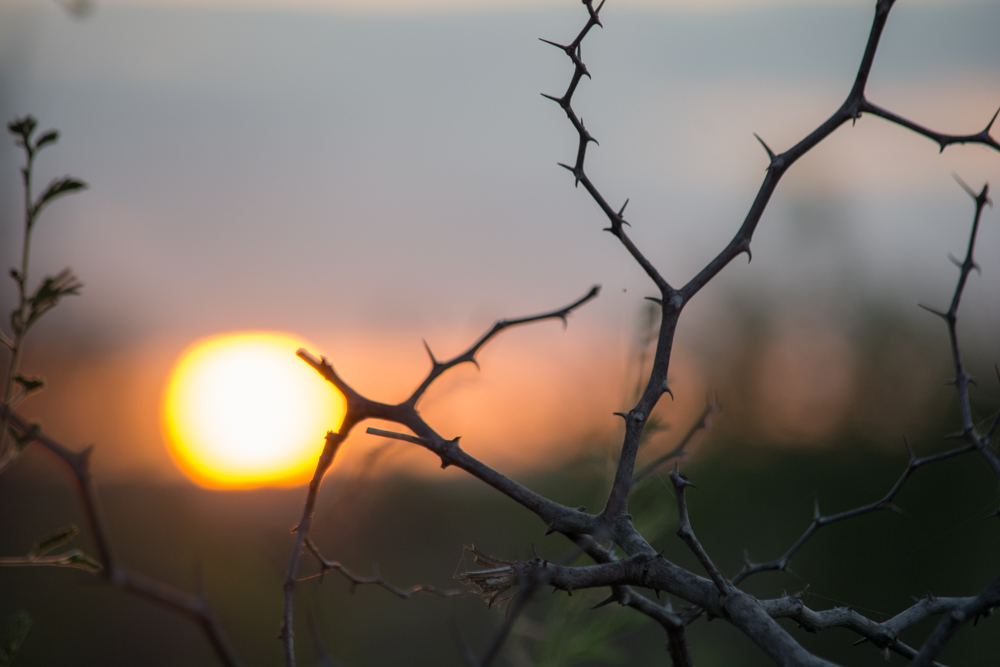
Photo by Melanie van Zyl.
5. Skukuza day walk
Get away from the traffic at Kruger’s busiest area and peep through thorn thickets at the rising sun and enjoy the flat, easy-walking terrain. Skukuza is known as a wildlife hotspot and was the busiest of all the walks I went on. We tracked two rhinos and watched them graze from atop an anthill for at least seven minutes before a camera click finally gave us away. I was going to change my booking to an afternoon walk, but both receptionists advised I stick to the morning because afternoons tend to be much hotter and the activity of the animals is less. Afternoon walks from Skukuza leave at 4 pm and cost R478 per person.
Walks for day visitors in Kruger
Morning walks for day visitors cost R555.50 per person and walkers meet their guides at the respective gates at 5am before being taken into the park.
6. Crocodile River walk
Great for day visitors looking for another way to experience South Africa’s famous wildlife park. Generally speaking, this southern edge of Kruger is good for seeing the Big Five, wild dog and cheetah. There aren’t wilderness trails in this area so it’s the only way you’ll see this part of the park on foot.
7. Orpen’s morning walk
A wonderful way for visitors to experience the quieter side of southern Kruger, with the best chance for spotting plains game and cheetah. Scattered trees and wide-open plains make it a great option for a morning walk that’s just far enough away from the buzz of southern Kruger to feel like it’s untrammelled. Grazers favour this area because it’s open and ostensibly safer. This also makes it a good hunting ground for cheetah. It’s unlikely you’ll experience that kind of action, but following the highway carved by moving elephant the night before and stopping to examine the spoor is an excellent way to experience this lesser-visited area.
8. Olifants short walk
Spot crocodiles, hippo, elephant, and water birds on this short, mid-morning walk that will appeal to the not-so-early risers. Olifants Rest Camp offers a two-hour mid-morning walk that’ll get you down onto the banks of the wide river. Expect to see hippo and crocodile up close. And because it starts at 9.30 am, day visitors entering Phalaborwa Gate are able to do the walk. Malelane, Phabeni, and Phalaborwa also offer morning walk for day visitors. It’s also more affordable at R262.60 per person.
Getting to Kruger
The easiest way to get to Kruger from Gauteng is via Nelspruit. Be sure to opt for the Schoemanskloof turn-off after Machadodorp on the N4 to avoid roadworks. The road via Bushbuck Ridge isn’t great, so drive slowly and watch out for straying cars on the unlined roads. If heading north towards Phalaborwa Gate then head up the N1 and turn off at Polokwane towards Tzaneen.
Need to know
Trained field guides armed with rifles take adults and children over 13 out into the bush (maximum eight people). Morning walks generally last four hours but is easy-going; most are less than four kilometres with a break for snacks (you also score an early-morning game drive to catch nocturnal sightings of animals such as hyena before the walk as you are driven about half an hour to the departure point). Afternoon walks are shorter (about two hours). Bring binoculars, a camera, comfy walking shoes and neutral, dark clothing, and a hat.







